In this article, you’ll learn What is Sunk Key? Its Diagram, Functions, Selection, Types of Sunk Key, Advantages, and Applications are all explained with pictures.
Also, you can download the PDF file at the end of this article.
What is Sunk Key?
The term “sunk key” refers to a key that fits into keyways both in the shaft and in the secured member of the machinery. Simply put, these are keys in which one half fits into the pulley’s keyway while the other half rests in the shaft’s keyway.
It is, therefore, keyways are required both on the shaft as well as on the hub of the mating element. It is a standard form of key and maybe either have a rectangular or square cross-section.
This article provides a table below that shows the standard dimensions (sizes) for square and rectangular cross-section sunk keys. So let’s discuss this in detail below.
Read Also: What are the Applications of Cotter Joint? PDF
Function of a Sunk Key
In sunk key, power is transmitted due to the shear resistance of the key. The relative motion between the shaft and the hub is also prevented by the shear resistance of the key. Therefore, sunk keys are suitable for heavy-duty applications since there is no possibility of the key slipping around the shaft.
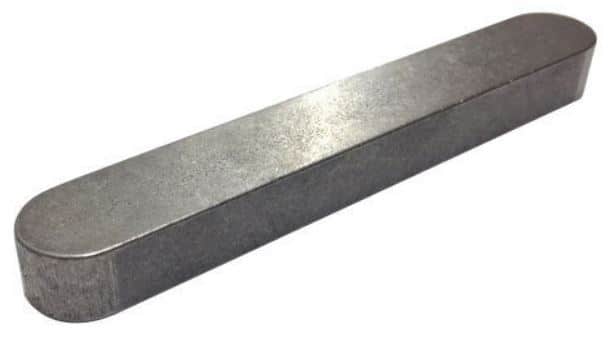
These types of keys are positive drives. This is the main advantage of the sunk key over the saddle key. However, it is necessary to cut keyways both on the shaft and the hub. As a result, the sunk key joint is more expensive than the saddle key joint.
There is widespread use in the practice of square or rectangular-shaped sunk keys. A sunk key with a rectangular section is called a flat key. The flat has more stability as compared to a square sunk key.
Square keys are used in general industrial types of machinery. Flat keys are convenient for machine tool applications where additional connection strength is desirable.
Read Also: Function of Knuckle Joint: Diagram, Parts, & Applications
Selection of Sunk Key
A thumb rule can be used when selecting a square key without stress analysis. In industry, square keys with a side dimension of 1/4 of the shaft diameter and a length of 1.5 times the shaft diameter are used.
or,


Where,
- b = key width (mm)
- h = key thickness or height (mm)
- l = length of the key (mm)
- d = diameter of the key (mm)
For a flat key, the thumb-rule dimensions are as follows:

Read Also: What are the Different Types of Fasteners & Their Uses?
Sizes of the Sunk Key
Following are the dimensions of the square and rectangular sunk keys (in mm):
| Shaft Diameter (Above) | Shaft Diameter (Up to & Including) | Key Size | Keyway Depth |
|---|---|---|---|
| 6 | 8 | 2 x 2 | 1.2 |
| 8 | 10 | 3 x 3 | 1.8 |
| 10 | 12 | 4 x 4 | 2.5 |
| 12 | 17 | 5 x 5 | 3.0 |
| 17 | 22 | 6 x 6 | 3.5 |
| 22 | 30 | 8 x 7 | 4.0 |
| 30 | 38 | 10 x 8 | 5.0 |
| 38 | 44 | 12 x 8 | 5.0 |
| 44 | 50 | 14 x 9 | 5.5 |
| 50 | 58 | 16 x 10 | 6.0 |
| 58 | 65 | 18 x 11 | 7.0 |
| 65 | 75 | 20 x 12 | 7.5 |
| 75 | 85 | 22 x 14 | 9.0 |
| 85 | 95 | 25 x 14 | 9.0 |
| 95 | 110 | 28 x 16 | 10.0 |
| 110 | 130 | 32 x 18 | 11.0 |
| 130 | 150 | 36 x 20 | 12.0 |
| 150 | 170 | 40 x 22 | 13.0 |
| 170 | 200 | 45 x 25 | 15.0 |
| 200 | 230 | 50 x 28 | 17.0 |
Read Also: What is the Terminology used in Screw Threads?
Types of Sunk Keys
The following are the main types of sunk keys:
- Gid head key
- Woodruff key
- Feather key
- Round key
- Rectangular or flat sunk key
- Square sunk key
- Parallel sunk key
- Tangent Key
#1 Gib Head Key
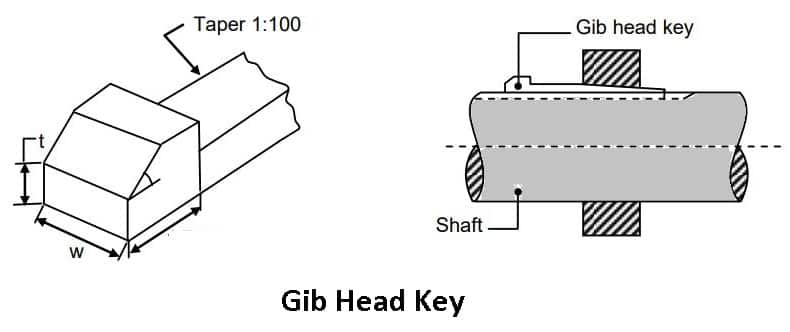
A gib head key is often considered suitable for all kinds of jobs and is the most popular type of keys. The top face of a gib head key is tapered, but its sides are parallel. It is a rectangular cross-section.
Its head is made towards its thick end, through which it can be easily taken out. It is important that it is completely tight, or else it may break or come out with a jolt. The thickness of the gib head shrinks to 1:100. These are mainly used to hold the gears and pulleys on the shaft tightly.
#2 Woodruff Key
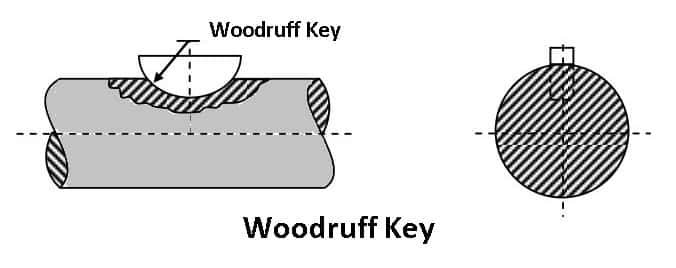
Woodruff key differs in shape from other keys. Upper part of the woodruff key is flat, and the bottom part is a semicircular disk of uniform thickness, which means it looks like a “half-moon”. The shaft contains a key way according to this key.
This keyway in the hub is made in the usual manner. The projecting part of the woodruff key fits in the keyway in the hub. Once the woodruff key is placed in position, it leans over and aligns itself on the shaft. It is mostly used on small shafts or spindles of fast speed for classes of work.
#3 Feather Key
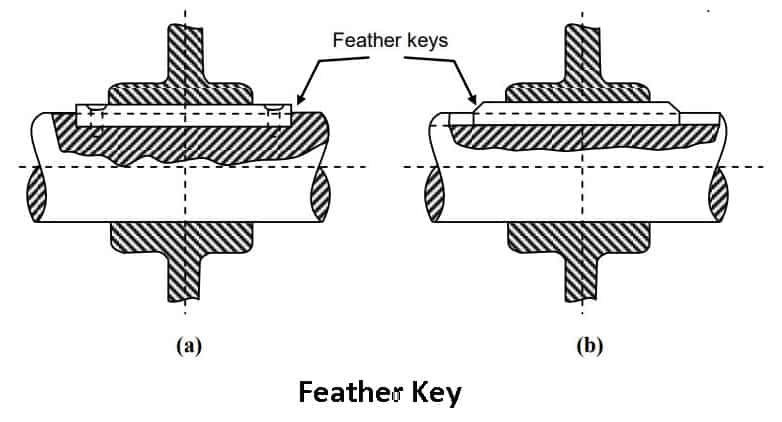
A feather key is of rectangular section and is not tapered. It is fixed either to the shaft or hub and permits relative axial movement between them. It is a type of sunk key with uniform width and height. In this type, there is a clearance fit between the key and keyway in the hub.
Thus, the hub can be slid over the key without interference. At the same time, there is no rotational movement between the shaft and the hub. Therefore, it transmits the torque and, at the same time, permits the axial movement of the hub. It is used where the parts mounted on the shaft are required to slide along the shaft, such as clutches or hear-shifting devices.
#4 Round Key
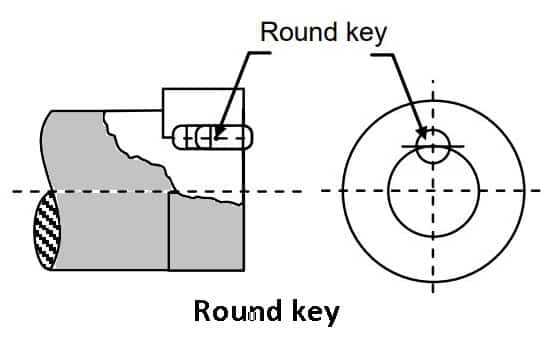
As the name suggests, the round keys are completely round and long in length. Since it consists of circular sections, they are drilled partly in the hub hole and partly in the shaft. These are in parallel or taper, but the shaft and hub are drilled accordingly.
It has a taper of 1:50 on the round key. By using round keys, the key drill on the mating part can be redrilled after assembly. Round keys are generally best suited for low-power drives. Sometimes the tapered pin is held in place by friction between the pin and the remade tapered hole.
Read Also: Types of Screws: Their Functions and Uses [Pictures]
#5 Rectangular or Flat Sunk Key
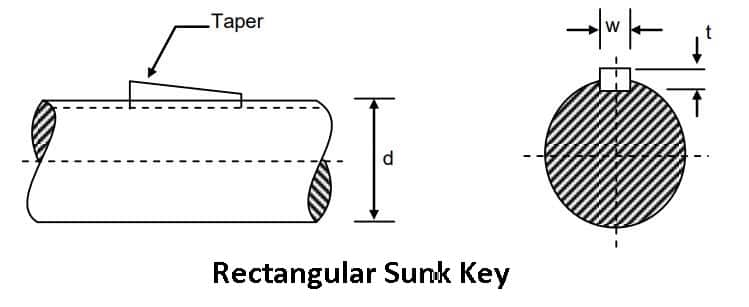
These keys are rectangular in shape and have a wider width than height, and are sometimes called flat keys as well. These types of sunk keys are typically specified for shafts with a diameter of 20 inches.
Common proportions of this key are:
Width of key, w = d / 4 ; &
thickness of key, t = 2w / 3 = d / 6
where d = Diameter of the shaft or diameter of the hole in the hub.
#6 Square Sunk Key
These keys have a square cross-sectional and can be used for larger shafts. The square key offers the same dimensions in width and thickness. Square keys are available with a diameter of 0.25 to 1.0 inches, but larger keys with a diameter of 6.5 inches are also available.
The only difference between a rectangular sunk key and a square sunk key is that its width and thickness are equal, ie.

#7 Parallel Sunk Key
Parallel sunk keys can be either rectangular or square sections, similar in width and thickness. It may be noted that the parallel key is taperless and requires a pulley, gear, or another mating piece to slide along the shaft when used.
The advantage of using parallel keys is that these keys are cheap and readily available. The form of keys is mostly used in the manufacturing and automotive industry due to their availability and ease of installation.
#8 Tangent Key
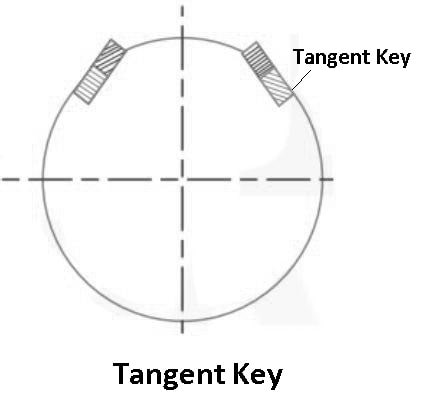
The tangent keys are fitted at right angles to the pair, as shown in the figure above. The keys are only intended to withstand torsion in one direction. Sinking keys are generally used in large heavy-duty shafts.
Read Also: Different Types of Nails and Their Uses [How To Use Them]
Advantages of Sunk Key
The following are the main advantages of using sunk keys:
- As compared to other keys, the sunk key has a high power transmission capacity.
- Since the sunk key has a positive drive, there is no slippage.
Disadvantages of Sunk Key
The following are the main disadvantages of sunk keys:
- The keyway is built into both the shaft and hub, so it is more expensive.
Closing It Up
That’s it. Thanks for reading. I hope I have covered everything about the “Sunk Key.” If I missed something, or if you have any doubts, let me know in the comments. If you liked this article, please share it with your friends.
Want free PDFs direct to your inbox? Then subscribe to our newsletter.
Download PDF of this article:
You may like to read more in our blog:
This blog post on Sunk Keys is incredibly informative! I particularly appreciated the breakdown of the different types and their specific functions. The PDF resource is a great addition for those wanting to dive deeper into the topic. Thanks for sharing such valuable content!
Thank you so much.